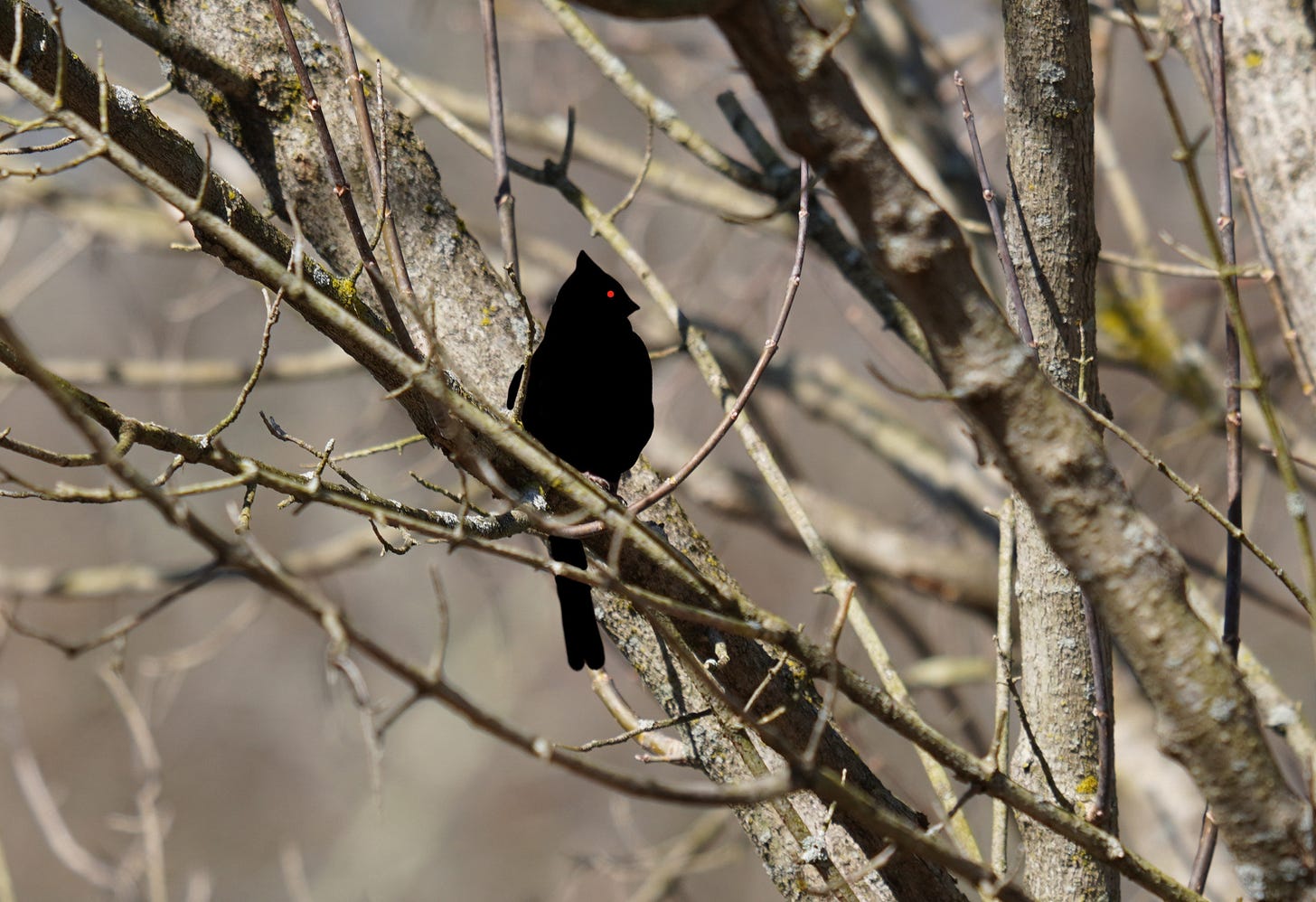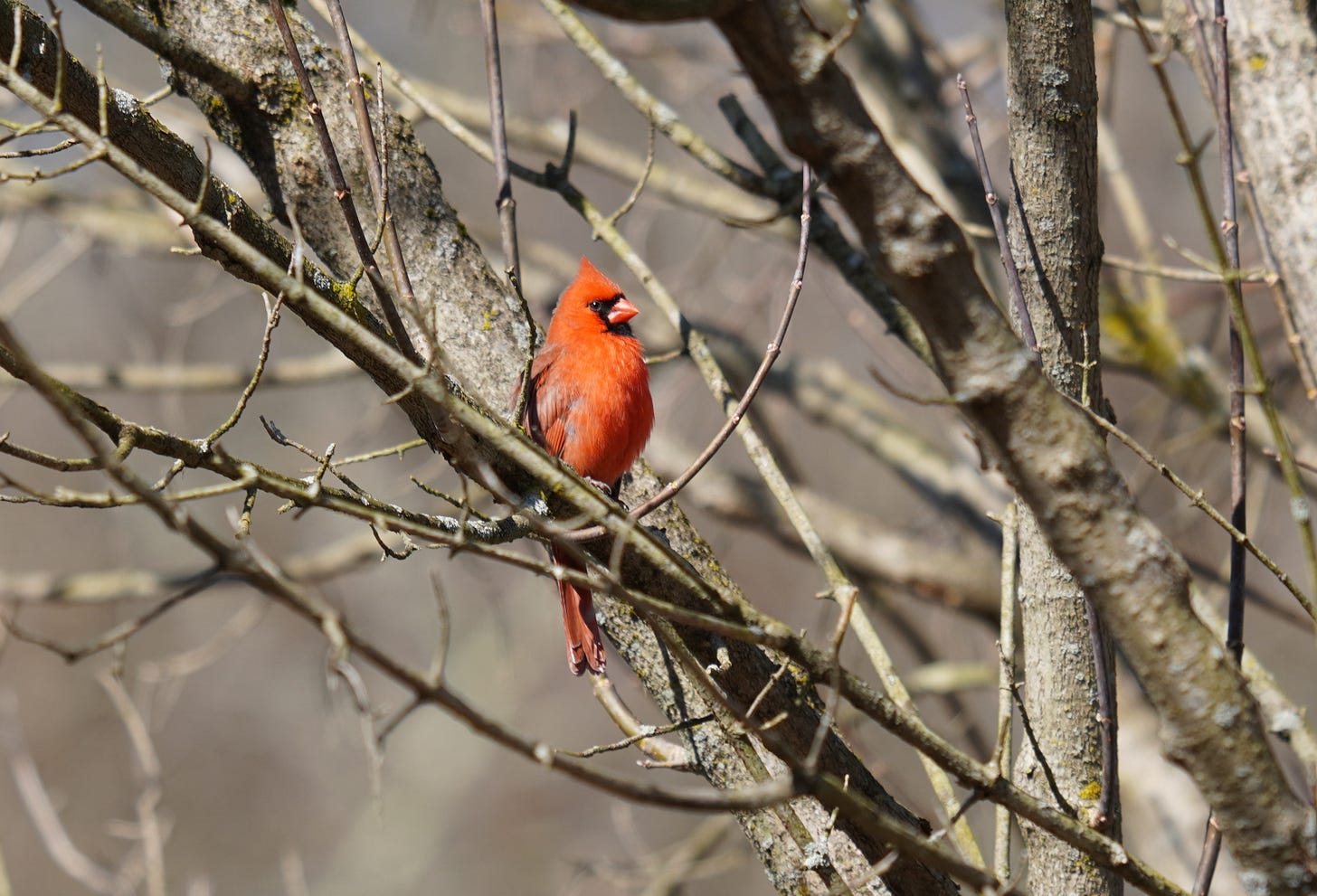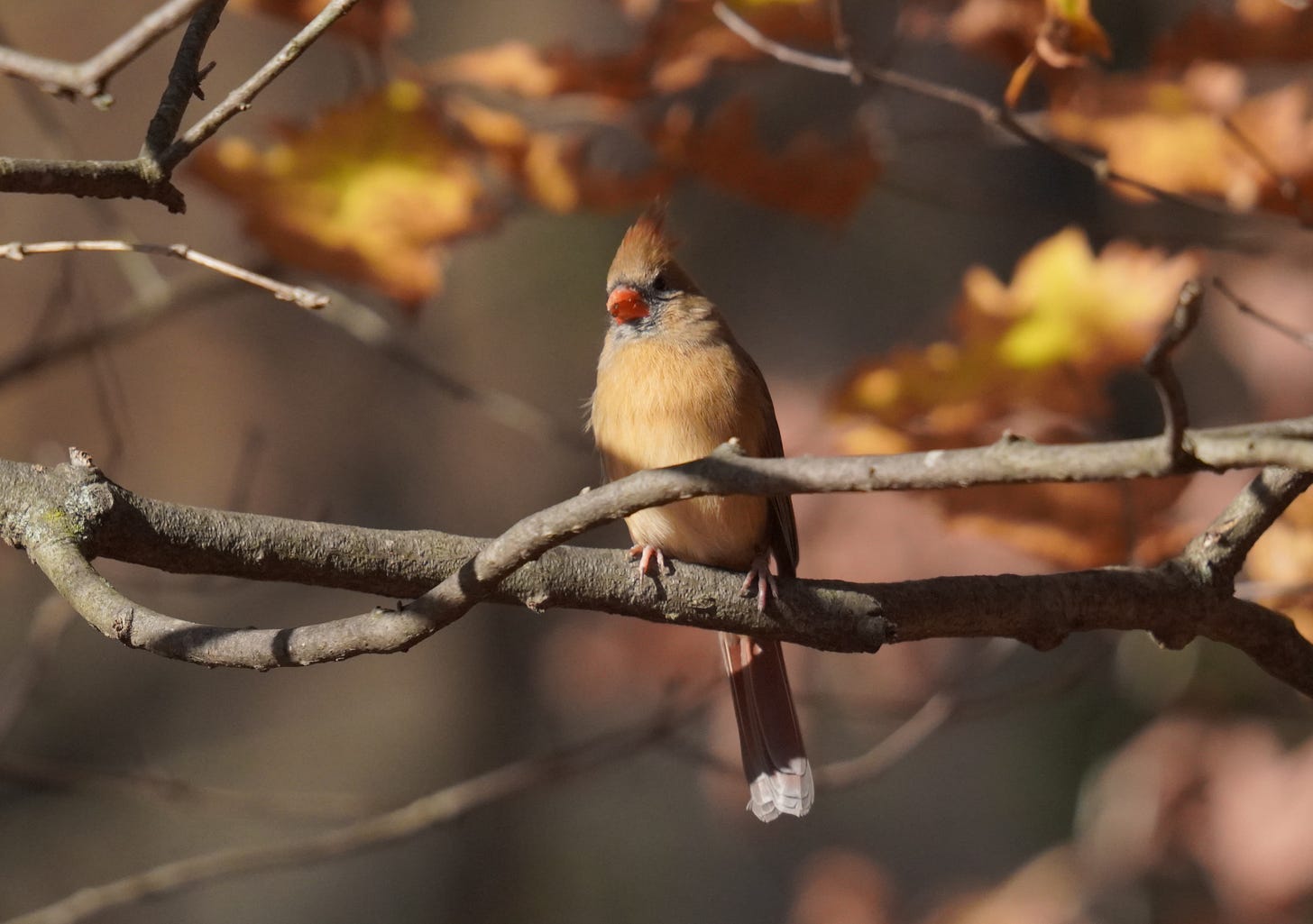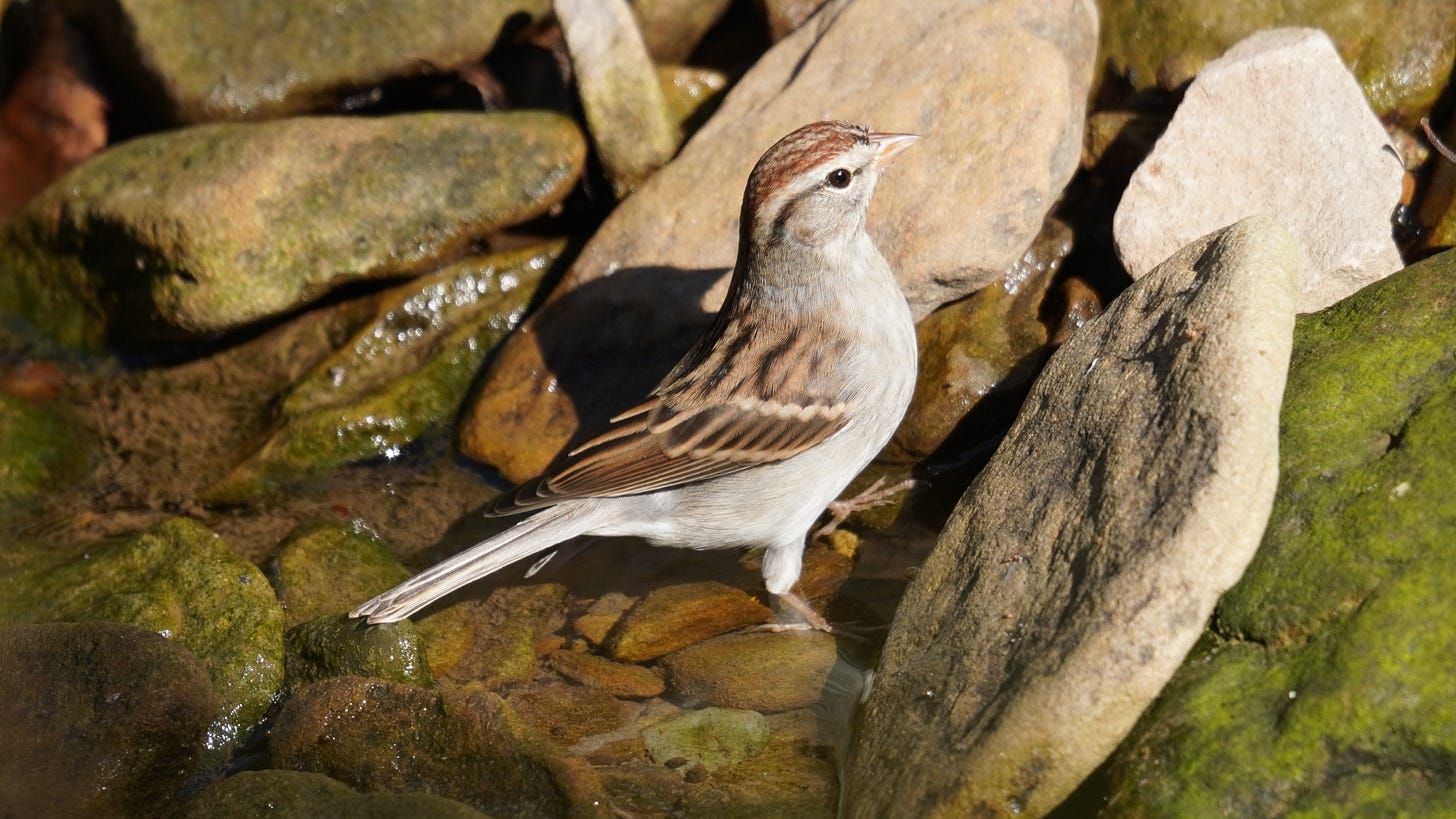The Dreaded Question
Or: How to Stump a Birder in Four Simple Words
Want to tie a birder in knots? Ask, “What’s your favorite bird?” then step back and watch the contortions.
That question flummoxed me recently, and even though I have a very easy answer, I somehow found myself squirming and lamely answering, “Ya know, I’m really into Ovenbirds lately.”
That “lately” is an important word because I think many birders will tell you their favorite is the last bird they saw, or one they’re currently captivated by. Recency bias does a lot of heavy lifting when it comes to picking a favorite bird. The answer is apt to change season to season, even daily. A new fav is just one sighting away.
And of course some birders straight up hate the question. Choose one? Out of so many? Ask me my favorite artist. Ice cream. Offspring. Anything but bird!
But that’s not me, so why did I answer Ovenbird? Did I think naming the common bird that’s my actual favorite would make me uninteresting? Did I fear that by not spouting some esoterica, my enrollment in the Cool Birders Club, some fictional clique whose members wear black turtlenecks and roll their own cigarettes, would suddenly be revoked? Or maybe some recency bias was in play there as well. Migration was hot. I’d been seeing Ovenbirds.
Either way, What’s your favorite bird? is the Dreaded Question for me too, and it’s one I rarely ask.
But I also think it’s a fair question. What’s your favorite (insert anything)? is such a foundational way to spark conversation, establish a connection, and foster a sense of relatability. It’s the ultimate icebreaker. As a kid, I wanted to know your favorite color. As a teenager, your favorite band. As a balding schlub? Your favorite beer, bourbon, ballclub (all the Bs). I especially want to know what birds you love. Have a favorite? I’m all ears. Though perhaps not the most sophisticated mode of engagement, What’s your favorite? gives us something to talk about. It may lead to disagreement, but it shows interest in the topic and the person. It’s childish in a good way.
And if you’re willing to humor me, I’ll tell you…
…that I am into Ovenbirds. Who wouldn’t be? With their olive-brown palette, streaky breast, bold eyering, and tendency to hang out on or near the forest floor, they’re a warbler trying their best to be a thrush. I had a great opportunity to photograph one that hopped out onto the trail about 5 feet in front of me last month, but of course I stumbled, and my clumsy hands fumbled, and by the time I had the camera ready, September was over and the bird was in Jamaica. No matter. Michael Fogleman managed to capture one better than I ever could, and in its oven-shaped nest, no less!
Yes, Ovenbirds are beautiful. Yes, they’re fascinating (how and why did they evolve to look like thrushes??). They even inspire poetry. Ovenbirds deserve to be someone’s favorite bird, insufferable teacher’s pets though they are.
But they’re not my favorite bird. That honor belongs to the one and only…
PHAINOPEPLA!
Lol jk, it’s the one and only…
NORTHERN CARDINAL!
I know. BOR-ring. Such a common bird. Such a ubiquitous bird. Wherever there’s a feeder, there’s a Cardinal. Where there’s a forest, a Cardinal. A hedgerow, a garden, a shrub, a single sunflower seed, a Cardinal. Check any eastern city, suburb, or wilderness, you’re going to find a Cardinal. If this database is correct, no fewer than 325 high schools and colleges have named themselves the Cardinals. If you need to guess the official bird of any state, pick Cardinal and there’s a 14% chance you’ll be right. (BTW, I stand firm that there should be no redundancies in state birds.) Hell, there’s even a whole set of sins named after them. That’s cause Cardinals know how to party.
Yep, Cardinals are just about everywhere in the eastern US (also don’t forget the small vagrant population in Vatican City), and we take them for granted (Rosemary Mosco has a funny comic about that), but they’re also amazing. Allow me to count the ways:
1. They’re beautiful. Cardinals are beautiful, and they look good year-round. Yes, okay, I know there’s that unholy molt phase (Mosco again), and then this pre-teen-looking SOB, ragged and ravenous, every bit like me after track practice in 7th grade.
But they’re usually beautiful, and in both sexes. Everyone knows the iconic male and his look-at-me finery. That dashing black mask. That color! Male Cardinals aren’t red. They’re RED!!! (here’s where a text-color feature would come in handy, Substack). But let’s take a moment to behold this female, the picture of elegance, less ostentatious but every bit as regal as she blends into the autumnal foliage. If Grace Kelly ever reincarnated as a bird, I think I just might have found her.
2. They’re here all year. Migration is magical, but where would we be without these year-rounders? When you get into the deepest, darkest grind of winter, when the sun is at its most miserly, when all the world seems shrouded in a doom-gray veil, there are the Cardinals, resplendant as ever, radiant in spite of it all. Unlike American Goldfinches, who slip yearly into a defeatist winter garb, Cardinals are proud, plump torches of hope, defiant in the waste.
3. They come in twos. If you see or hear one Cardinal, keep looking. Chances are the mate will be nearby. Good chance they’ll take the same mate next breeding season too, although a new year sometimes does come with a new mate, making them monogomous-ish. You know…sorta like us.
4. They sing! Speaking of coming in twos, oh how these birds sing, male and female alike. Few are the female songbirds who sing, yet female Cardinals not only match the males note for note, they oftentimes surpass the male song in their flutey duets. More on their vocal prowess below.
5. They’re easy. Big. Bulky. Conspicuous. First to the feeders in the morning, last at them in the evening, there all hours of the day. Even deep in a woodland thicket they give themselves away with their less-than-clandestine movement and incessant chipping. While their song is unmistakable, so too is their chip—loud and metallic, one of the easiest to learn. Yep, Cardinals are out here practically begging to make your eBird checklist.
6. They spark new birders. The words “common” and “captivating” may seem at odds with each other, but not when it comes to Cardinals. I wonder how many people have put up feeders for the sole purpose of attracting Cardinals, only to find themselves wondering who all else is showing up. A pair of binoculars and a field guide later, voilà! A new birder is born, and as I discussed last time, more birders is good for birds.
7. They’ll nest where you nest. If you have ample brush around your house, you’ll likely get nesting Cardinals, and if you get nesting Cardinals, you may get Cardinal babies. Cardinals nested often in the dense little bush in front of our Michigan home. Not the most opportune location, as it turned out, but since this is a cheerful post, I won’t delve into the grim details ☠️
8. They have crests. I think we can all agree that crested birds are peak 🔺
9. They’re dumb. Perhaps that’s uncharitable, but who said “amazing” was synonymous with “positive?” Cardinals have never struck me as the brainiacs of the bird world. Anecdotally, I once found a male Cardinal trapped in the garage of our Indiana (guess the state bird) home. Even when the door lifted to provide a huge, gaping escape route, the bird was unable to find his way out, no matter how I chased and shooed and jeered, “This way, genius.” Only when captured in a butterfly net and released did that poor moron know freedom once more. Dumb. Amazingly dumb.
10. They cure depression. That’s the Northern Cardinal’s superpower, its most amazing trait. Growing up in northeast Ohio, in a house by the woods, with a birding father who kept his feeders full, I’ve rarely known life without Cardinals. It was the first bird I could ID, and I can still recall the dialect they used in our Akron neighborhood, a bright and cheery CHEEW-chew, CHEEW-chew, CHEEW-chew-chew-chew! Maybe it’s mundane to call Cardinal song the music of my youth, but it was, and more than that, it was a vocal balm administered by unwitting avi-therapists who alone had the power to pull me from the most profound doldrums—middle-school winters, when sunless mornings ushered me half-alive to the bus stop, which in turn ushered me to the cruel halls of Litchfield Middle School (Argonauts, not Cardinals). In the wake of a bleak Akron winter, the spring song of Cardinals through an open window was so clean and pure and healing, so central to restoring my mental health, that I’m not only awed by them, I’m grateful as well. I would have survived public school without them, but I’m glad I didn’t have to.
Speaking of, last weekend I attended my 30th high school reunion (we were the Falcons of Firestone, rival to the Kenmore Cardinals). When the subject of birding came up and the Dreaded Question put to me, I confidently proclaimed Northern Cardinal.
It felt good, like being absolved of some kind of sin. I think I’ll lean into that answer from now on.
PS. I also happen to have a least favorite bird. Big reveal next week!
Featured Photo - Chipping Sparrow
Most places I’ve lived, I’ve associated the transition from summer to fall with the departure of one ground-feeding sparrow and the arrival of another. Chipping Sparrows will soon give way to Dark-eyed Juncos, but right now we’re in the narrow overlap period when both are around. On Monday, I spotted my first Junco of the season. Minutes later, I found this Chipping Sparrow taking a bath in a little stream that feeds the creek out back. I no longer dread winter and the seasonal blues. Getting outside daily has rid me of those, and seing Juncos and ducks and, yes, Cardinals has me actually looking forward to the cold months of the year. But it was nice to spend some time with this Chipping Sparrow. I’ll be happy to see them again come spring.
10/10 Recommends
Michael Fogleman is one of those people who seems maddeningly good at everything, including all things birds. He even somehow managed to harness eBird data to develop a Bird Finder. Spend some time with his ridiculously good Instagram. The up-close detail he captures, right down to a bug in a beak, never fails to astonish 📷 🦗🐦⬛
I linked two of her comics above, but Rosemary Mosco’s entire oeuvre is worth your time. A prolific science writer, birder, and absolutely brilliant cartoonist, her Bird and Moon series captures the absurdity of nature and all the most relatable human interactions with the natural world. She also appreciates pigeons like few others do 🕊️
Callback
Last week I vowed to find a coffee that was better for birds. My dear friend, talented childrens’ author and phenomenal birder Elizabeth Pagel-Hogan (10/10 recommend), suggested I try Chesapeake Coffee Roasters bird-friendly coffees, so that’s what I’m doing. Review soon! ☕
That’s all for now. Thanks for reading. If you have a favorite bird, or a strong opinion one way or another about the Dreaded Question, let me know in the comments!
Until next time, bird your ass off!
nwb







I’m with you—the cardinal is my fave, and I love to hear them sing. They do like to be up high, too! I’m happy we have so many here in Michigan.
I recently was amused to read that Ted Floyd said his favourite bird was the planet Mercury:
"I am positive that my spark bird was not yours. Now as you already know, my favorite bird is the planet Mercury. And my spark bird was—wait for it—Didelphis virginiana, the Opossum."
https://blog.aba.org/2012/03/ted-floyd-my-favorite-bird.html
But then he later said it was Bushtit, so who can say...
https://www.aba.org/how-to-know-the-birds-no-32-my-favorite-bird-the-bushtit/